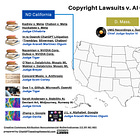Giving credit for "consent, credit, and compensation" where it's due: an origin story for the 3Cs and 4Cs of creative rights
What I found when investigating whether the 3C (consent, credit, compensation) framework was lifted from Cultural Intellectual Property Rights Initiative® without consent, credit, or compensation.
Earlier this year, I began writing articles about ethics of generative AI for music. In several of those posts, I referenced the “3C’s” (consent, credit, and compensation) and “4C’s” (consent, control, credit, and compensation) which I had seen mentioned in some LinkedIn posts and articles. (Maybe you have used it too, or have seen references like this?)
This post explores the origins of the 3C and 4C phrases, traces where credit is due, and shares how to give proper credit.
This article is not a substitute for legal advice and is meant for general information only.
Where did the 3Cs come from?
I first read about the 3 C’s in a LinkedIn post about AI and creators’ rights, citing a business magazine article, earlier this year. The “3C’s” and the “consent, credit, and compensation” phrase also came up in many articles about ASCAP seeking to protect their creative members’ AI-related rights. No origin was identified for the phrase.
Where did the 4th C come from?
I saw 4C’s, adding “control” to the list, mentioned in LinkedIn posts from reputable activists and the Algorithmic Justice League (led by
). No origin was identified for the phrase.Where are 3Cs and 4Cs referenced?
Over the past 6 months, I saw dozens of articles that mentioned 3Cs, and a few that mentioned 4Cs. After seeing the 4Cs variation, I adopted it in my writing. I’ve referenced 3Cs and 4Cs in many of my Substack articles, including “Musician-led initiatives [Unfair Use series, PART 3]”:
“By default, we assume artist-focused initiatives like this are ethical. The artists, or the people who own the rights to their work, consent to use of their content and their name, image, and likeness. And they can control its use, credit, and compensation. That covers all 4Cs.”
Origin Discovery
Just this past week, I discovered CIPRI (Cultural Intellectual Property Rights Initiative®). They work to protect and promote the rights of Indigenous people, ethnic groups and local communities, particularly for textiles and fashion. Although CIPRI was officially launched in April 2018, their “3C Rule Consent. Credit. Compensation.” phrase was established and protected in 2017. Since I had seen no copyright marks or trademarks in any of the references I read earlier this year about the 3Cs or 4Cs, possible CIPRI origination was a concern and surprise.
Discovering this 2017-era trademarked & copyrighted phrase raised the possibility that, in a twist which would be deeply ironic, the 3 C’s framework itself which ASCAP and others are using may have been (inadvertently, one hopes) adopted without Consent, Credit, or Compensation to this initiative / cultural intellectual property rights group. ☹️
CIPRI’s site and posts indicate that their rights to the “Consent, Credit, Compensation” phrase are doubly protected (global copyright and geographical trademark). Their website was established in 2018, although CIPRI’s LinkedIn presence seems to be less than a year old. As of 2018, the CIPRI website has stated “The 3Cs' Rule: Consent. Credit. Compensation© (2017)”.
Their LinkedIn posts include indications of:
Trademark: 5 months ago, CIPRI quoted “3C RULE CONSENT. CREDIT. COMPENSATION™” in a LinkedIn post about Cultural IP Month.
Copyright: 9 months ago, CIPRI posted “Great to see the 3Cs' Rule: Consent. Credit. Compensation© developed by Cultural Intellectual Property Rights Initiative® (CIPRI) reflected in the Draft Next Steps.” in a LinkedIn comment on a WIPO director’s post.
The CIPRI website shows that Cultural Intellectual Property Rights Initiative® was registered as a trademark (R) in the EU in September 2020. The CIPRI website also indicates that they do not consider the scope of their 3Cs rule to be limited to their textile and fashion domains:
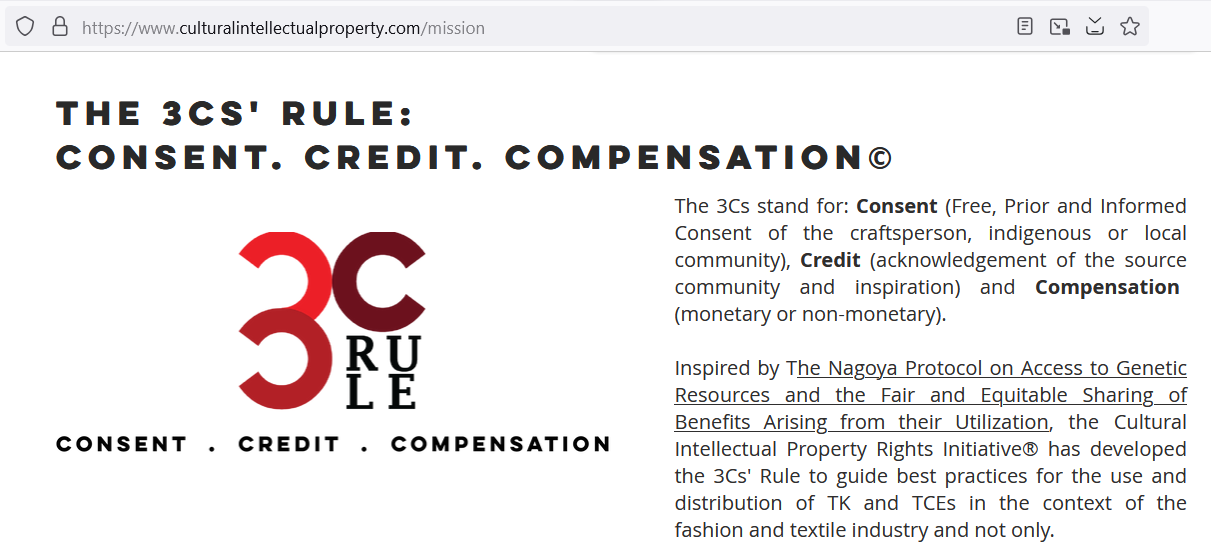
Investigation
I did some (non-AI) searches and found many references to 3Cs and 4Cs. Some articles also call out “3Cs + T” or “CCCT”, where the T is for Transparency. Only a handful of pages correctly acknowledged CIPRI:
citation of CIPRI “3C Rule” copyright on goodonyou.eco
a chapter in 2023 book “Sustainability Challenges in the Fashion Industry” which cited it correctly
TAEC Laos organization (“Traditional Arts and Ethnology Centre”) which cited and linked to CIPRI
a Medium article “Consent, Credit, and Compensation: The 3C’s to Build Equitable Business Ecosystems” which credits CIPRI (although it does not show their trademark or copyright).
It also cites UNESCO document “Building resilient and sustainable cultural and creative sectors” [1] which I haven’t yet read (it’s 331 pages).
Based on searches to date as of Sept. 27, no other sites or posts using any of these phrases had yet credited CIPRI for the 3Cs or as inspiration for these and other derivations.
In the interest of building cooperation, rather than ‘name and shame’ others who (like me) didn’t know about the origins, I am not publishing the long list of articles I found referencing the 3Cs and 4Cs without credits.
3Cs and WIPO (World Intellectual Property Organization)
I found references to WIPO incorporating the 3Cs in their work on T K (Traditional Knowledge), released in May 2024. However, the WIPO documents do not refer to AI or to use of computerized images of creations. [2]
4Cs and AJL (Algorithmic Justice League)
All references I found to the 4Cs appear to have originated with the Algorithmic Justice League, or from people like me who echoed the 4Cs phrase. One LinkedIn post credited AJL with originating the 4Cs phrase.
The AJL web page aimed at writers shows the use of the 4Cs, and points people to the Action Network page (which references the 3Cs) for signing the Authors Guild open letter.

3Cs Usage: RightsAndAI.com
The RightsAndAI.com website positions them as a central clearinghouse for companies and individuals to “reserve”, endorse, and support their Declaration of rights. They state that they are “Defending The Rights Of The World’s Content Creators & Rightsholders”, ending their statement with the 3Cs:
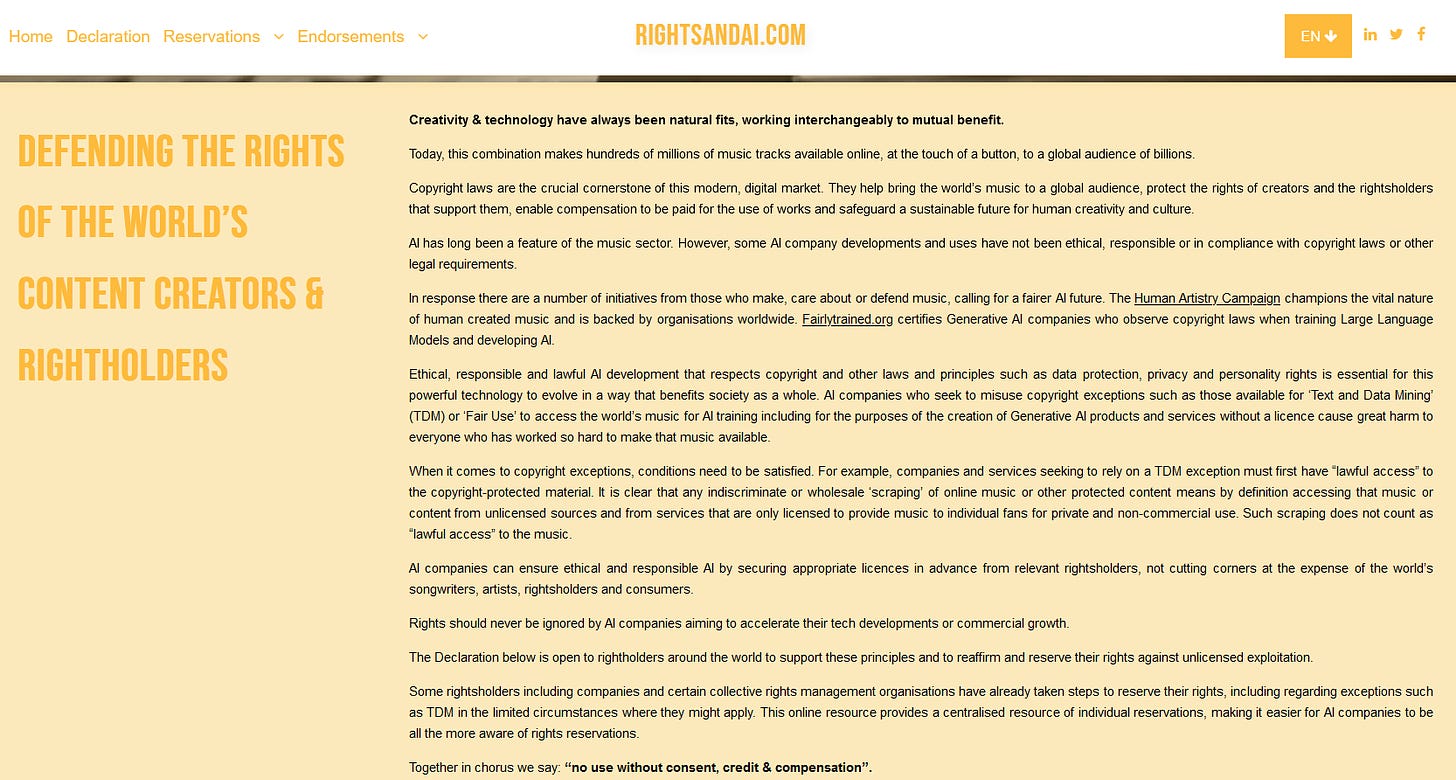
To date, over 1200 rightsholders have become listed as signatories, and about 30 other ‘organisations and creators’ have endorsed the declaration:
3Cs Extension: ASCAP (American Society of Composers, Authors and Publishers)
ASCAP (American Society of Composers, Authors and Publishers) is a major “performance-rights organization” (PRO) for songwriters and musicians, with over 920,000 members.
In mid-2023, ASCAP defined six guiding principles for AI. These were announced by ASCAP CEO Elizabeth Matthews in June 2023 and quoted in a Sept. 2023 guest column in Billboard Magazine by ASCAP President and Chairman Paul Williams.
Of ASCAP’s six guiding principles for AI, three of them are the 3Cs.
Screenshot from the ASCAP website (use alt text if the print is too small to be legible):
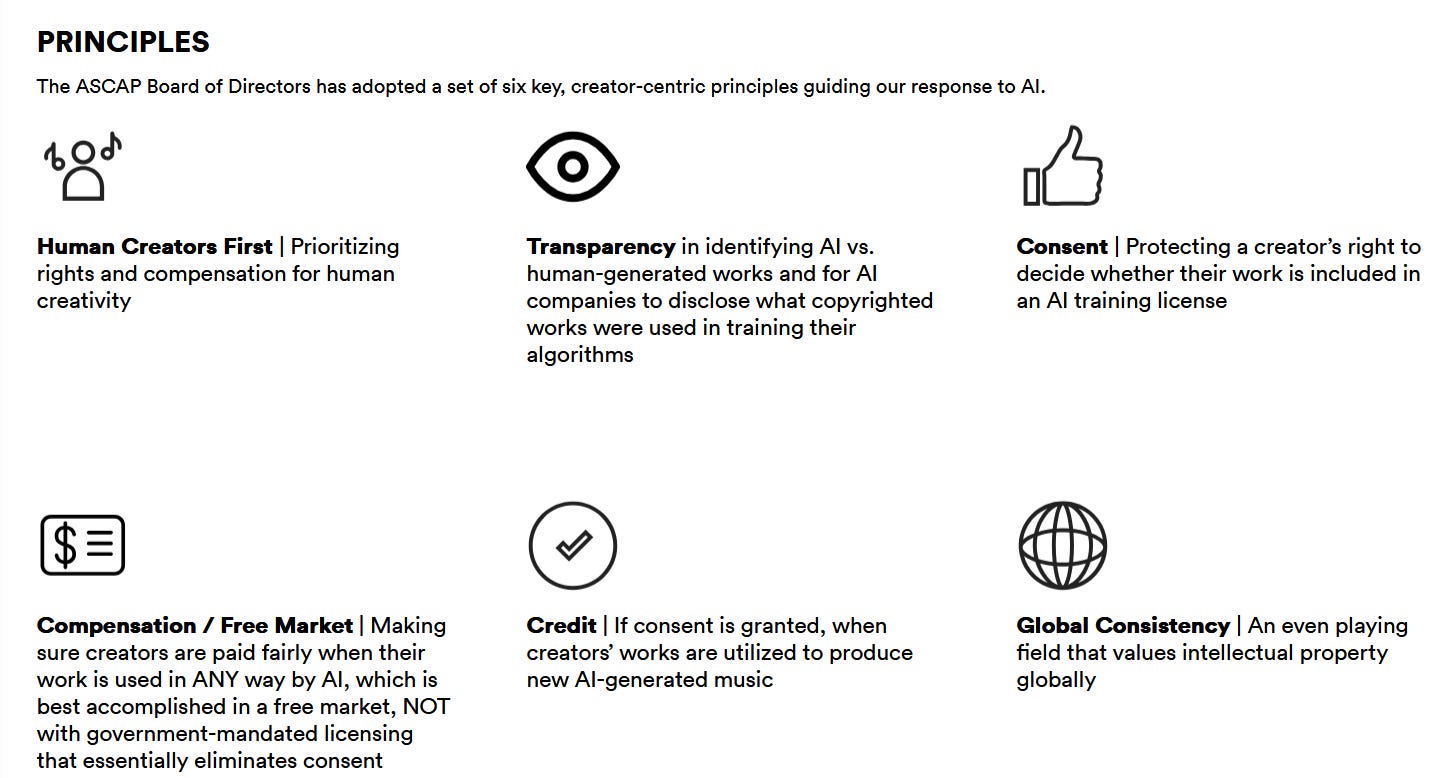
3Cs Derivation: Human Artistry Campaign
The Human Artistry Campaign is a related organization that launched in early 2023. The supporting members extended beyond ASCAP and RIAA to a wide range of industries, including SAG-AFTRA, the AFL-CIO, publishers, and several professional sports players’ leagues. However, CIPRI is not listed, and there was no clear connection to the textiles or fashion industries where CIPRI originated.
At SXSW in Austin on March 16, 2023, HAC announced their seven principles, which cover & extend the 4Cs. Each of the 7 principles has further detail on their website.
Interestingly, the 7 HAC principles encompass “control”, but do not use CIPRI’s “3C Rule” phrase. And they never use the word ‘credit’; instead, under transparency, they reference “clear identification of a work’s provenance” and say that “content generated solely by AI should be labeled describing all inputs” — i.e., credit.
The seven HAC principles are:
“Technology has long empowered human expression, and AI will be no different
Human created works will continue to play an essential role in our lives
Use of copyrighted works, and the use of voices and likenesses of professional performers, requires authorization and free-market licensing from all rightsholders [consent and control]
Governments should not create new copyright or other IP exemptions that allow AI developers to exploit creators without permission or compensation
Copyright should only protect the unique value of human intellectual creativity
Trustworthiness and transparency are essential to the success of AI and protection of creators
Creators' interests must be represented in policymaking”
Where Curiosity Led Me
After finding these uncredited references, I contacted CIPRI and AJL to inquire about the origins of their 3Cs and 4Cs expressions. I do not yet have a response from AJL. However, CIPRI founder Ashoka Fellow Monica Boţa Moisin, responded the next day to provide this context for their 3Cs “soft law framework”:
“The 3Cs' Rule: Consent. Credit. Compensation© (2017) was first presented to the public in December 2017 in the TEDx Talk "Cultural Fashion: Transform the Fashion Industry from Villain to Hero" at the Technical University in Munchen, Germany, and was subsequently distributed via YouTube on 21st February 2018. This led to the creation of the Cultural Intellectual Property Rights Initiative® in April 2018.”
CIPRI considers the 4th C added by AJL, Control, to be “implicit when the 3Cs are in place”. And they do consider AI applications to be within the scope of their IP for 3Cs. In fact, Monica informed me:
“Like you mentioned, the 3Cs (Consent, Credit, Compensation) have also been linked to training AI generative models to respect the rights of artists and other categories of creators. I will be hosting a presentation on this topic specifically based on a case study from my practice involving the Oma ethnic group of Laos, on 17th October 2024, part of an event hosted by the UNESCO Chair on Intangible Cultural Heritage in Public and Global Governance from the University of Warsaw, Poland. I will share a link to the event if it's open to the public.”
CIPRI has indicated that they generally use:
“The 3Cs' Rule: Consent. Credit. Compensation© (2017)” to indicate the year of creation, and
“3C RULE CONSENT. CREDIT. COMPENSATION™” where there is mention of trademark registration.
But no matter how the 3Cs Rule is written or used, it requires crediting CIPRI.
3Cs and UNESCO (United Nations Educational, Scientific and Cultural Organization)
Although “3C Rule: Consent. Credit. Compensation” is not explicitly referenced and linked to CIPRI, Monica gave a presentation on “The 3Cs' Rule: Consent, Credit, Compensation© (2017) Framework” at UNESCO headquarters in Paris during an expert meeting in Sept. 2023 on economic dimensions of Intangible Cultural Heritage (ICH) safeguarding [3].
Monica kindly informed me that UNESCO’s experts who are mandated to work on AI and ICH know about CIPRI’s work. This is borne out by the UNESCO 2023 survey, which was distributed by the UNESCO Secretariat to the Convention on safeguarding ICH. The 3Cs are listed on the survey as options, to be included in a policy proposal related to AI and artists' rights for the next Mondiacult conference in 2025 [4]:
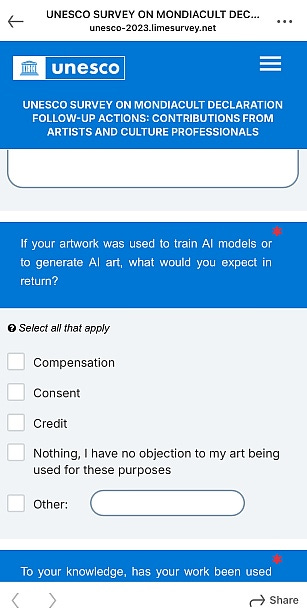
Aside from the UNESCO cooperation, the few examples I listed above show that recognition and proper credit for CIPRI from international organizations, companies, or individuals (like me) has been sparse so far.
Bottom Line
Monica’s email confirmed my reaction that use of CIPRI’s 3C framework without giving them credit would be an unacceptable (and highly ironic!) form of colonization. Monica noted that I was the first person to ask them for explicit consent. She indicated that her main interest is in Credit for the 3Cs Rule. Her vision is:
“Our goal however is for the 3Cs to be the basis of policy and governance in various domains - not only fashion, traditional knowledge and cultural expressions. … The impact we seek is for these 3Cs Consent. Credit. Compensation. to no longer be an exception, but the rule.”
The “ship has already sailed” on ‘Free, Prior and Informed Consent’ for many existing uses of the 3Cs phrase. Even if it’s after the fact, it’s still important to confirm CIPRI’s Consent and give proper Credit on the old posts - and to continue to seek Consent & share Credit appropriately on new uses in the future.
CIPRI encourages the use of the 3Cs’ Rule across sectors with appropriate crediting.
Crediting CIPRI acknowledges the 3Cs Rule as a legal strategy which demonstrates the understanding required for implementing consent, credit, and compensation as a method for nurturing, sustaining, and protecting.
Simple and fair, right? So let’s all use it and credit it. I’m committing to do 4 things:
I’ve updated all of my old LinkedIn and Substack posts (and added notes to other posts) on AI ethics and music. All posts now give proper credit to CIPRI as the originator of the 3Cs and inspiration for the 4Cs, using this language **:
Credit for the 4Cs (consent, control, credit, compensation) phrasing goes to the Algorithmic Justice League (led by Dr. Joy Buolamwini).
Credit for the original 3Cs (consent, credit, and compensation) belongs to CIPRI (Cultural Intellectual Property Rights Initiative®) for their “3Cs' Rule: Consent. Credit. Compensation©.”
I’ve contacted AJL, ASCAP, and RightsAndAI.com about credit to CIPRI, on the AJL 4Cs being inspired by the 3Cs, and on RightsAndAI and ASCAP reuse of the 3Cs.
I am privately contacting the authors of the articles I found in my search who referenced the 3Cs or 4Cs to encourage them to share credit to CIPRI.
I will support CIPRI and AJL however I can to encourage ASCAP, HAC, the Authors Guild, and others who reference the 3Cs or 4Cs to credit them appropriately.
“I did then what I knew how to do. Now that I know better, I do better.”
(Maya Angelou)
Where We Stand on These Rights Today
Previous studies found broad global support for these creative rights [5]. Public sentiment in the US remains strongly supportive of these principles. A new voter survey was conducted in July 2024 and released on Sept. 12 [6]. Although relatively small (808 people), it found that broad bipartisan “supermajorities” of people in the US believe creative works (in particular, voices, music, and images) should not be used for AI without consent, credit, and compensation. Here’s one example from the report:
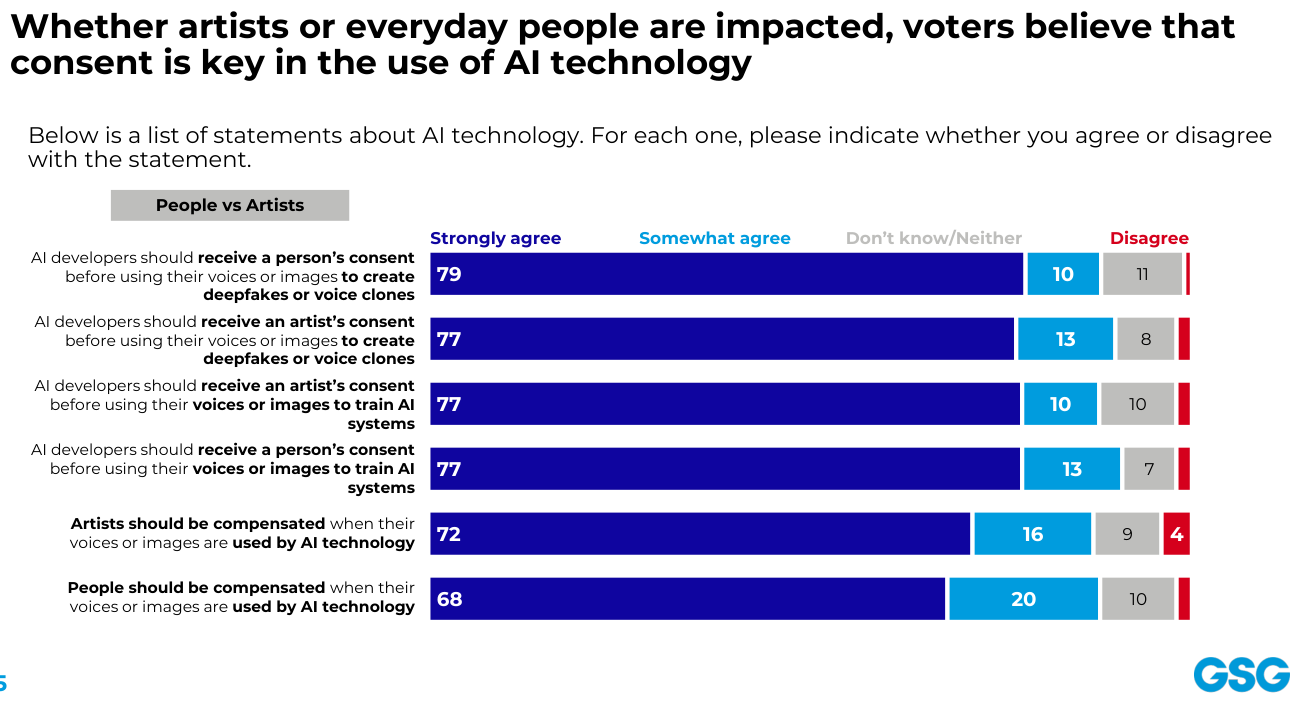
We are seeing some emerging signs of corporate acceptance that content for use in AI tools requires Consent - i.e., it should be duly licensed and not stolen. While still fighting the 30+ active lawsuits in court [7], AI companies have been negotiating with corporations who control the 3Cs for large bodies of works by multiple creators. End Note [8] lists two OpenAI examples. Other companies such as Adobe, Canva, and Stability AI are pursuing similar actions [9]. Credit and traceability (providing links to source works) appear to be part of the discussions, with Compensation implicit in the Consent negotiations. However, open questions remain:
Will the original content creators
have any option for consent/control over how their works are used?
ever see any of that compensation? (or will the corporations keep the funds?)
What actions will be taken to proactively ensure that these creative rights are correctly enforced?
What’s Next?
VOTE: In the USA, our task as voters is simple. In November, we need to elect representatives at all levels who align with our views on ensuring consent/control, credit, and compensation for creators. (ASCAP is actively encouraging its members to register and vote, specifically because of AI and copyright issues.) Voters in other regions can and should do likewise in their upcoming elections.
RAISE AWARENESS: Anyone who has a voice or influence in a organization for creatives is encouraged to help to raise awareness of creators’ rights by using the 3Cs Rule, with proper credit** to CIPRI.
GIVE CREDIT: Anyone is welcome to reuse my language above** to give CIPRI proper credit for defining the 3Cs and inspiring support. (A link to this article is appreciated, but not required). Please share widely and freely to encourage ethical credit to CIPRI for the 3Cs and wide use of the 3Cs to support creators’ rights:
I’ll post an update in this newsletter on the 3Cs and AI after Monica gives her presentation at the UNESCO-hosted event on Oct. 17! Subscribe to be notified automatically of future posts - it’s FREE.
References
“My novel was stolen by a robot – and used to train AI without my consent”, Damian Barr / The Independent, 2023-09-27
Article reporting on musicians' uses and fears about AI, including studies that flagged the potential impact of AI-based cultural appropriation on indigenous peoples in Australia and New Zealand
End Notes
WIPO documents relating to the 3Cs:
Links from UNESCO headquarters expert meeting in Paris, Sept. 2023, on economic dimensions of intangible cultural heritage (ICH):
Surveys and studies on public opinion about creatives’ rights:
Updates on AI lawsuits and US copyright law:
Latest interactive lawsuit map update: chatgptiseatingtheworld.com, 2024-08-17
Latest text update on lawsuit statuses: chatgptiseatingtheworld.com, 2024-09-25
Axios articles on OpenAI content licensing deals, May 2024:
News Corp, 2024-05-22
The Atlantic and Vox Media, 2024-05-29
“How should creators be compensated for their work training AI models?”, Michelle Cheng / Quartz, 2023-10-20. “Companies like Adobe, graphic design company Canva, and generative AI startup Stability AI are coming up with incentive plans for people who contribute artwork to the AI training models.”
6 'P's in AI Pods is a 100% reader-supported publication (no ads, no affiliate links, no paywalls on new posts). If you enjoy my work, I’d love to have your support via shares, hearts, restacks, Notes, one-time tips, or voluntary donations via paid subscriptions!





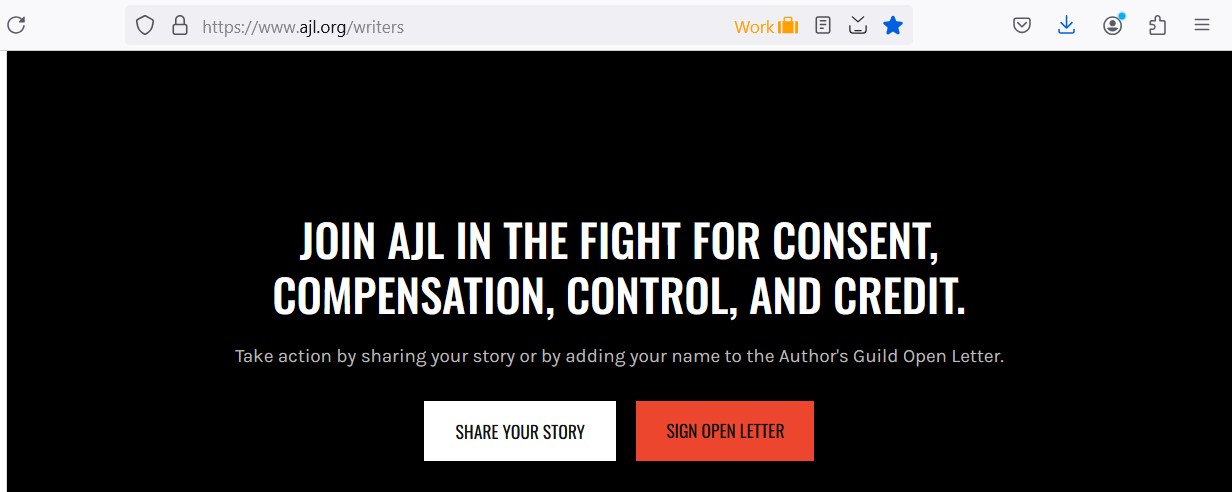

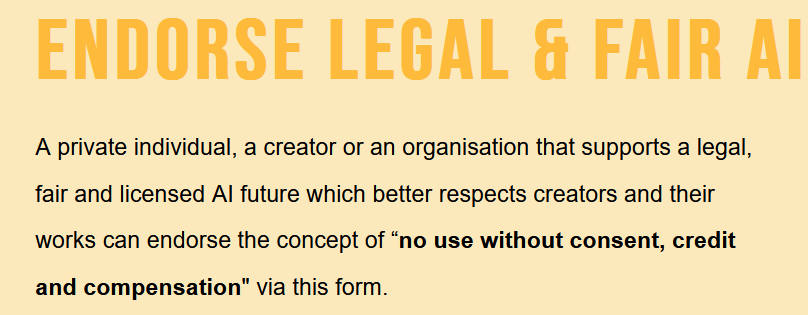
![Musician-led AI initiatives [Unfair use? series, Part 3] 🗣️](https://images.unsplash.com/photo-1593697972679-c4041d132a46?crop=entropy&cs=tinysrgb&fit=max&fm=jpg&ixid=M3wzMDAzMzh8MHwxfHNlYXJjaHwyMnx8bXVzaWMlMjBjb21wdXRlcnxlbnwwfHx8fDE3MjAzMDk0NDJ8MA&ixlib=rb-4.0.3&q=80&w=1080)
![Ethical Risks & Challenges in GenAI music [Unfair use? series, PART 2]](https://substackcdn.com/image/fetch/w_140,h_140,c_fill,f_auto,q_auto:good,fl_progressive:steep,g_auto/https%3A%2F%2Fsubstack-post-media.s3.amazonaws.com%2Fpublic%2Fimages%2Ff43d4635-1899-4964-b093-ced7dda4c29e_1600x1066.jpeg)
![Ethical AI Standards by Region [PART 2 Supplement in "Unfair use?" series]](https://substackcdn.com/image/fetch/w_140,h_140,c_fill,f_auto,q_auto:good,fl_progressive:steep,g_auto/https%3A%2F%2Fsubstack-post-media.s3.amazonaws.com%2Fpublic%2Fimages%2F2433d7cf-2fc3-49fd-af0f-8fbd8dfe33ac_3362x1530.jpeg)
